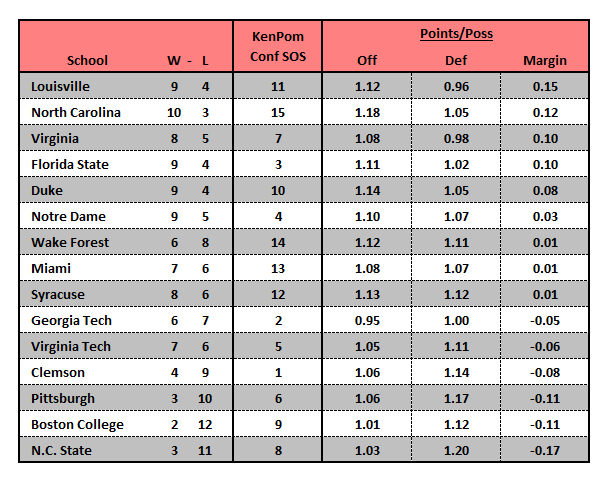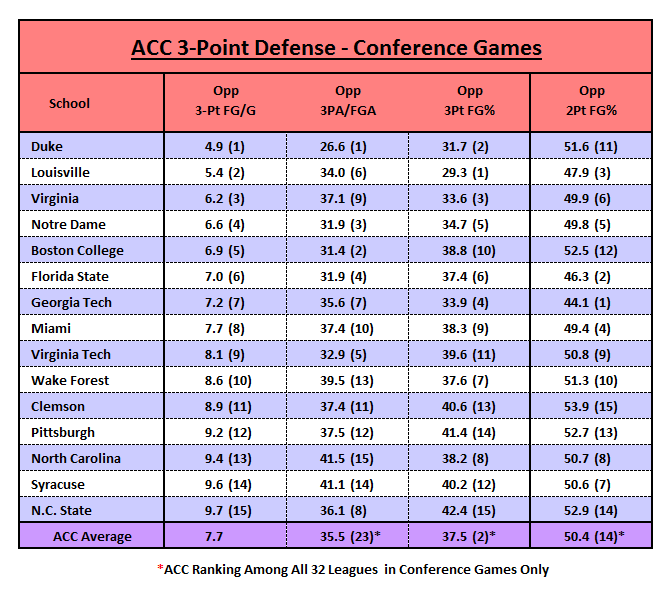Inside the ACC Numbers: Volume V
Posted by Brad Jenkins (@bradjenk) on February 17th, 2017Here is the latest edition of our weekly review of the current ACC standings and team performances where we focus on which teams are playing better or worse than their records indicate. Each week we delve into advanced metrics to reveal a few interesting teams, player statistics, and trends. This week we will compare how ACC teams defend the three-point line. Finally, we forecast how the final ACC standings may look given current efficiency margins, and what that means for teams’ postseason aspirations.
Note: All data is current for games played through Wednesday, February 15.
Current Standings
ACC teams continue to be bunched close together at the top of the standings as well as in efficiency margins — the schools that have played easier conference schedules look better in points per possession. Things are about to even out with respect to schedule difficulty, however, among the league’s top six squads. Here’s what each of those schools has remaining against one another:
- North Carolina (4 games) – Virginia, Louisville, @ Virginia, Duke
- Louisville (2) – @ North Carolina, Notre Dame
- Duke (2) – Florida State, @ North Carolina
- Virginia (2) – @ North Carolina, North Carolina
- Florida State (1) – @ Duke
- Notre Dame (1) – @ Louisville
North Carolina clearly has the toughest remaining slate, but at least three of those four difficult contests will come in the Smith Center where the Tar Heels have yet to taste defeat this season. Florida State and Notre Dame have the easiest closing batch of games, with just one each against the rest of the top tier. According to KenPom, North Carolina’s conference schedule has been about four points per game easier than those faced by the Seminoles and Irish. That gap is about to shrink considerably, and by year end we would expect ACC strength of schedule to essentially even out among the top six contenders.
Advanced Statistic of the Week: Defending the Three-Point Line

A few weeks ago, we looked at the crazy-hot shooting in the ACC this year from behind the arc. Today we examine how the league’s defenses are coping with this trend Studies have shown that a defense has very limited control over opponents’ three-point accuracy — in fact, the best predictor of a team’s three-point shooting percentage is usually the opponents’ two-point defensive percentage. The logic behind this conclusion is that teams that excel at defense tend to do so all over the floor. The table above seems to align with this theory with one glaring exception. It’s no secret that Mike Krzyzewski‘s teams at Duke have an almost maniacal aversion to hot three-point shooting. In the 15-year history of tempo-based stats, the Blue Devils have never finished outside of the top 24 nationally in opponents’ three-point attempt percentage. And unlike most schools, Duke traditionally fares much better at forcing shooters to miss from distance than it does from inside the arc. It’s as if the Blue Devils care so much about defending the three-point line that they are willing to accept the tradeoff of giving up easy twos. Going forward, the Blue Devils’ Achilles’ heel in the NCAA Tournament may be an opponent that doesn’t rely on the deep ball — one that is, however, well-equipped to exploit Duke’s softer interior defense.
Looking at these numbers reveals another noticeable exception. Note that North Carolina is the only team in the top six of the ACC standings that does not rank among the top ACC schools at limiting three-pointers made by opponents. Roy Williams has never been a coach that makes stopping threes much of a priority, relying instead on dominant offenses and powerful rebounding to win lots of games and championships. But with the recent national explosion in three-point acumen, it could be problematic for the Tar Heels in postseason play if opponents are allowed to bomb away successfully on days when North Carolina doesn’t dominate the offensive glass.
Future Forecast

The above table shows predicted order of finish with final regular season records based on KenPom’s current win probabilities for each team. Also included are a few comparative rankings that are mentioned frequently when evaluating NCAA Tournament potential, as well as projections from two bracketology experts — ESPN‘s Joe Lunardi and CBS Sports‘ Jerry Palm. Note that while they project the field as if it were named tomorrow, we make our projections based on the final KenPom projected records. At this point, Miami and Virginia Tech are probably just a couple of wins away from giving the ACC eight NCAA Tourney locks. Other bubble schools like Wake Forest, Syracuse and Georgia Tech have more work ahead, but we should expect at least two more to get there even with 14 overall losses. One reason for that is that it is just not a strong year for several conferences that normally receive three to five bids — i.e., the SEC, AAC, Atlantic 10 and Mountain West. The Selection Committee has to fill out a 68-team field somehow, so a few teams with profiles that typically would not be deemed worthy of inclusion will get in this year.










































